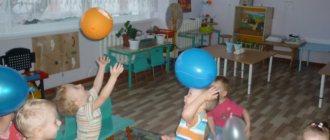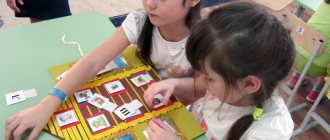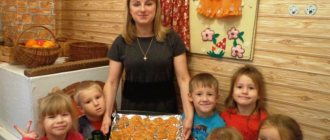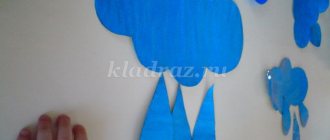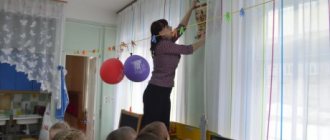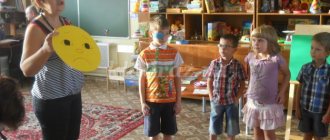Program content
• Strengthen the ability to compare two equal and unequal groups of objects using methods of superposition and application, use expressions as much - as, more - less.
• Exercise in comparing two objects by size, denoting the results of comparison with the words big, small.
• Learn to determine the spatial arrangement of objects using the prepositions on, under, in
etc.
Didactic visual material
Demonstration material.
Large and small dolls, doll furniture, doll clothes for walking in two sizes.
Handout.
Outline images of blouses with eyelets, circle buttons.
Guidelines
Part I. Game exercise “Let’s help the doll choose clothes for a walk.”
On the carpet is a model of a room with pieces of furniture for a doll. Doll clothes are laid out on the bed, on a high chair, under a high chair, in a closet, etc. Children, together with the teacher, find clothes and clarify their location, using the prepositions on, under, in
and etc.
Part II. Exercise “Sewing buttons to a blouse.”
Each child has a contour image of a blouse with eyelets and a button (one less than the buttonholes). The teacher gives the task: “You need to sew (attach) a button to each eyelet. How many loops? How many buttons? What is more - loops or buttons? Which is smaller - buttons or loops? Make sure there is a button in each eyelet.”
Part III. The teacher invites the children to compare the dolls by size and choose clothes for them for a walk: coats, hats, shoes, etc.
Lesson 2
Program content
• Improve the ability to distinguish and name geometric shapes: circle, square, triangle, ball, cube.
Didactic visual material
Demonstration material.
Three cards depicting geometric shapes (a circle, a triangle, a green square, a blue circle; three circles of different sizes in yellow, a yellow triangle, a large yellow circle; a small red circle, a large circle, a triangle and a circle in green, yellow and Red); a bag containing large and small cubes and balls of different colors and sizes.
Handout.
Sticks (4 red and 3 green sticks for each child), strings.
Guidelines
Part I. Game "Find the extra piece."
The teacher one by one shows the children cards depicting geometric shapes (circle, square, triangle), invites them to look at them and asks: “How do the shapes differ? How are the figures similar? Which figure is the odd one out? Why?"
Part II. Game "Let's build a figure."
Each child has 4 red and 3 green sticks and a string.
The teacher gives the task: “Make a square from red sticks. Show him his sides. Make a circle out of string. Circle it with your hand. Make a triangle out of green sticks. Show its sides and corners."
Part III. Game "Wonderful bag".
The teacher recites the quatrain:
I am a wonderful little bag, I am a friend to all the guys. I really want to know how you like to play.
The “wonderful bag” contains large and small cubes and balls of different colors. Children identify geometric shapes by touch, then take them out and name the colors.
Lessons 3–4
Free planning of work taking into account the assimilation of program material and the characteristics of a specific age group.
Appendix I
Didactic games and game exercises
Didactic games and exercises are recommended to be carried out in order to clarify and consolidate mathematical concepts in children both in the classroom and in everyday life.
Quantity
• Improving the ability to compose a set of individual elements and select elements from the set: “Airplanes”, “Multi-colored lanterns”.
• Improving the ability to find one or many objects in a specially created environment: “Bear and Bees”, “Cat and Mice”, “Let’s Find Toys”, “Let’s Put Things in Order”.
• Consolidating the ability to compare two equal and unequal groups of objects in different ways (by superimposition and application): “Determine who has more (less)”, “Let’s arrange flowers in vases”, “Treat the animals”, “Find the same amount”, “In which Are there more in a row?”, “Butterflies and flowers”, “Who brought more toys?”, “Finger games”.
Magnitude
• Improving the ability to compare two objects in length, to indicate the results of comparison with the words long - short, longer - shorter
: “Whose path is longer?”, “Let’s put the pencils in boxes,” “Pick up some strings for the doll.”
• Improving the ability to compare two objects in width, to indicate the results of comparison with the words wide - narrow, wider - narrower
: “Hide the mouse in the hole,” “Let’s jump over the stream,” “Pick up scarves and ribbons for the doll,” “Let’s roll the ball into the goal.”
• Improving the ability to compare two objects in height, to indicate the results of comparison with the words high - low, higher - lower
: “Let’s build turrets.”
• Improving the ability to compare two objects by size, to indicate the results of comparison with the words large - small, larger - smaller
: “Let’s give toys to Mishka and Mishutka,” “Find the same ring.”
Form
• Improving the ability to distinguish and name three-dimensional figures based on tactile-motor examination: “Wonderful bag”, “Balls and cubes”, “Let’s roll the ball (cube) to the gate”, “Mailbox”.
• Improving the ability to distinguish and name flat figures: “Which figure is gone?”, “What has changed?”, “Find a pair” (“Find your place”), “Wonderful bag”, “Pick up the key to the lock”, “Play classics” (“Magic paths”), “Collecting beads (garland)”, “Making a pattern”, “Let’s repair the rug”.
MAGAZINE Preschooler.RF
Municipal institution "Department of Preschool Education" of the Executive Committee of the Nizhnekamsk District of the Republic of Tatarstan Abstract of the educational activity “Cognition” on the topic: “Let’s dress the doll for a walk” Educator: Frolova A.S.Let's dress the doll for a walk.
Objectives: To expand children's knowledge about clothing. Enrich children's vocabulary on the topic. Teach children to classify clothes according to a given criterion (winter or summer) Reinforce the concepts of color, size, shape, quantity. Develop differentiation of auditory and visual perception. Equipment: Doll in a blouse and pants, winter clothes, box. Cut out pictures of mittens and felt boots, different colors, with “holes” in the form of geometric shapes; similar geometric shapes. Educational areas: Cognition. Physical Culture. Communication. Nod's move: Greeting "Everyone clapped their hands" Everyone clapped their hands, Together, more fun! Our feet started pounding, louder and faster! We'll hit you on the knees. Hush, hush, hush. We raise our hands, our hands, higher, higher, higher! Our hands began to spin. They went down again. They circled, circled and stopped. Surprise moment “A doll is riding” Tryndi-bryndi, balalaikas, A doll is riding in a tarataika. The teacher takes out the doll. Guys, look, the doll Katya came to visit us. Katya wants to go for a walk, but doesn’t know what to wear. She wants to go outside in a blouse. Can I walk around in a blouse now? -No. -And why? What time of year is it outside now? Winter. -What happens in winter? -Snow, frost, wind, -That's right guys, it's cold in winter, which means you need to dress warmly. Let's help Katya get dressed: What to wear, a hat, the right one, and what else. -A fur coat. -Yes, right. Well, Katya is ready. Now Katya is warm. Look, have we dressed Katya all up? nothing was forgotten. -That's right, mittens, you also need felt boots. Oh, guys, look, our mittens and felt boots have holes in them. You can't walk in them. What to do! I came up with an idea, let’s put patches on mittens and felt boots. Here on our tables there are mittens on one side and felt boots on the other. Look, the holes in all felt boots are different, but this felt boot has a round hole, so what kind of patch is needed? Correctly round, etc. And the mittens need to find a patch of the same color and shape, Lera, what kind of mitten do you have? It's red, but the hole is so square. This means the patch should be red and square. Children put on patches themselves. At the end, the teacher asks what patches they installed. Now our Katya won’t be cold, she puts on mittens and felt boots. How you and I dressed Katya correctly, warmly, in a winter way. Now Katya won't freeze. Guys, Katya is inviting us for a walk. Let's go for a walk together.
| Next > |
Lesson summary “Dressing the Katya doll for a walk”
Clothes in winter. Final lesson in the second junior group “Dressing the Katya doll for a walk”
Integration of educational areas: “Cognition” (formation of a holistic picture of the world, “Labor”, “Communication”, “Socialization”.
Types of children's activities: play, communication, cognitive-research, productive.
The goals of the teacher’s activities: to give the concept of the generalizing word “clothing”; learn to differentiate types of clothing by season, name items of clothing; introduce children to the art of applique, develop interest in this type of activity; develop the ability to freely arrange an image on paper; show children the dependence of a child’s health on clothing and the time of year; to cultivate a careful, careful attitude towards one’s own clothes and the clothes of others, activity, observation, independence.
Planned results of the development of integrative qualities of a preschooler: emotionally interested in following the development of action in games - dramatizations (Katya’s doll coming to the children for help, answering the teacher’s questions, participating in conversations during the classification of clothes, in the game “Pick up a set of clothes for a walk”,
Progress of the lesson
1. Org. moment. Greetings.
children enter the group and sit at the tables.
Let's guys smile at each other and start the lesson.
2 Surprise game moment. (knock on the door)
A sad doll Katya, dressed in summer clothes, comes to the children’s group.
Question: Let's say hello to Katya. (Draws the children’s attention to the appearance of the doll) What happened to Katya, what do you think? (Children's answers.) Now listen to Katya. Yes, she’s trembling all over... (addresses Katya). Katyusha, why are you sad? Are you sick?
Kate. I was walking outside and was very cold, I saw a kindergarten and decided to come to you to warm up.
V o s p i t a t e l. Why is Katya frozen? What time of year is it now? What is she wearing? (Silk dress, shoes, hat.)
Kate. What clothes are you wearing now? (Children talk.)
-Why do you need to dress like that (in order not to get sick, it’s already cold outside, you need to take care of your health.)
- But I don’t know how to dress properly.
Educator: The guys will help you. Shall we help you guys?
3. Game “Set of clothes for a walk.”
Children are offered landscape pictures depicting different seasonal weather - it’s raining, winter, summer - the sun is shining, autumn and spring.
On the tables there are object pictures depicting clothes and attributes for them –1. Raincoat, rubber boots, umbrella; 2. Winter coat, hat, mittens, scarf, felt boots;
3. Dress, shoes, swimsuit; 4. Autumn jacket, hat, boots, scarf; 5. Spring coat, hat, elastic bands.
